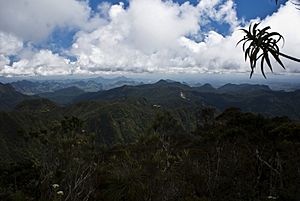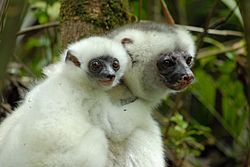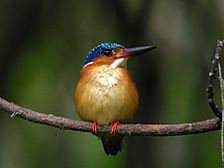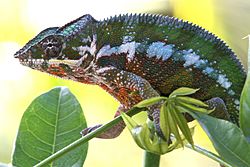Marojejy National Park facts for kids
Quick facts for kids Marojejy National Park |
|
|---|---|
|
IUCN Category II (National Park)
|
|
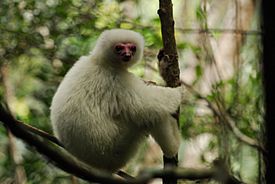
Marojejy is home to the Silky Sifaka
|
|
| Location | Antsiranana Province, Madagascar |
| Nearest city | Andapa and Sambava |
| Area | 560.5 km2 (216.4 sq mi) |
| Established | 1952 (Natural Reserve) 1998 (National Park) |
| Governing body | Madagascar National Parks |
| World Heritage site | 2007 |
Marojejy National Park is a special national park located in northeastern Madagascar. It's a place known for its amazing variety of plants and animals. Many of these species can only be found here!
Scientists often visit Marojejy to discover new species. Sometimes, they find plants or animals that have never been seen before. This makes the park a very important place for nature.
Contents
Amazing Nature at Marojejy

Marojejy National Park is famous for its incredible variety of living things. It has many different types of natural homes, called habitats. Many of the plants and animals here are endemic, which means they live only in this area and nowhere else on Earth.
Scientists are always finding new species in the park. Some of these new discoveries are already in danger of disappearing. For many small creatures, like invertebrates (animals without backbones), we still have a lot to learn!
Plants of Marojejy
The plants in Marojejy National Park are very diverse. This is because the park has different small climates. For example, plants grow faster on the wet eastern slopes. On the drier western slopes, they grow slower. Strong winds and poor soil also affect plants on the mountain tops.
So far, over 2,000 types of flowering plants have been found here. Some plant families like Clusiaceae and Poaceae are common everywhere.
There are four main types of forests in Marojejy:
- Lowland Rainforest: This forest is below 800 m (2,600 ft). It has the most different kinds of plants because it gets lots of rain and stays warm. The trees are very tall, reaching 25–35 m (82–115 ft) high. Their tops form a thick canopy. You can find many palms, epiphytes (plants that grow on other plants), and ferns here. About 130 types of ferns live in this area. This type of forest covers 38% of the park.
- Moist Montane Rainforest: This forest is found between 800 and 1,400 m (2,600 and 4,600 ft). It also covers 38% of the park. As you go higher, trees and shrubs get smaller. This is because it's cooler and the soil isn't as good. Tree ferns become more common here. The tree canopy is about 18–25 m (59–82 ft) tall. There's more humidity, which is great for mosses and ferns.
- Cloud Forest: This forest is between 1,400 to 1,800 m (4,600 to 5,900 ft). It covers 11.5% of the park. The trees here are much shorter and often twisted. Their canopy only reaches 10 or 15 m (33 or 49 ft) high. Moss and lichen hang from the tree branches. It's cooler here, and thick clouds often cover the forest. Many species found here live only in this specific area.
- Montane Scrub: This is found above 1,800 m (5,900 ft) and covers only 1.5% of the park. It's like an open, tundra-like area with thin, rocky soil. The plants here are very short, usually less than 2 m (6.6 ft) tall. You can find low, dense shrubs, orchids, and tiny palms and bamboos. This is the only high mountain scrub in Madagascar that hasn't been changed by fires.
Marojejy is home to 35 types of palms. Some of these are in critical danger of disappearing. Seven types of palms can only be found in Marojejy. The park also has over 275 types of ferns, with seven found only here. Many of these ferns are very rare.
The park also protects rare rosewood and palisandre trees. These trees are known for their beautiful wood. Rosewood is a deep red, while palisandre is not red. Sadly, many of these trees have been cut down illegally. This is why some types of Dalbergia trees are now listed as "vulnerable" or "endangered".
Animals of Marojejy
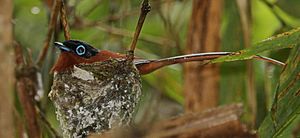
Marojejy National Park is famous for two special animals: the helmet vanga (a bird) and the critically endangered silky sifaka (a type of lemur). The silky sifaka is one of the "The World's 25 Most Endangered Primates". There are fewer than 1,000 silky sifakas left in the world, and none live in zoos.
The park has an amazing number of different animals. For example, 75 out of 118 types of birds found here live in the forest. This is more than any other mountain area in Madagascar! All these forest birds are found only in Madagascar. One rare bird, the Madagascar serpent-eagle, was not seen by bird experts for many years until 1990.
Besides the silky sifaka, Marojejy is home to 10 other types of lemur. Many of these lemurs are also endangered because their homes are being destroyed. The aye-aye, a nocturnal lemur, has only been seen once in the park. Other mammals include 15 types of tenrecs, seven types of native rodents, the fossa, and the Madagascar sucker-footed bat.
The park also has many different reptiles and amphibians. It has more types than any other protected area in Madagascar! A total of 148 species have been found. 17 of these are found only in Marojejy. These include two types of chameleons, Brookesia karchei and Chamaeleo peyrieresi. You can also find the colorful panther chameleon and many types of frogs here. Small creatures like large millipedes, spiders, and leeches also live in the park.
Visiting Marojejy National Park
Marojejy National Park has three camps where visitors can stay overnight in the forest. These camps have wooden bungalows, places to eat, a small kitchen, and toilets and showers.
- Mantella camp (at 475 m (1,558 ft) altitude)
- Marojejia camp (at 775 m (2,543 ft) altitude)
- Simpona camp (at 1,275 m (4,183 ft) altitude)
Protecting the Park
Sadly, some people illegally cut down valuable trees like rosewood in Marojejy National Park. In 2009, it was estimated that thousands of rosewood trees were cut down without permission. This harms the park's unique forests and the animals that live there. Efforts are being made to stop this illegal activity and protect Marojejy's precious natural resources.
Images for kids
-
The cliff named Ambatotsondrona is made mostly of gneiss rock.
-
Many people near the park are subsistence farmers. They grow rice by slash and burn farming.
See also
 In Spanish: Parque nacional de Marojejy para niños
In Spanish: Parque nacional de Marojejy para niños


